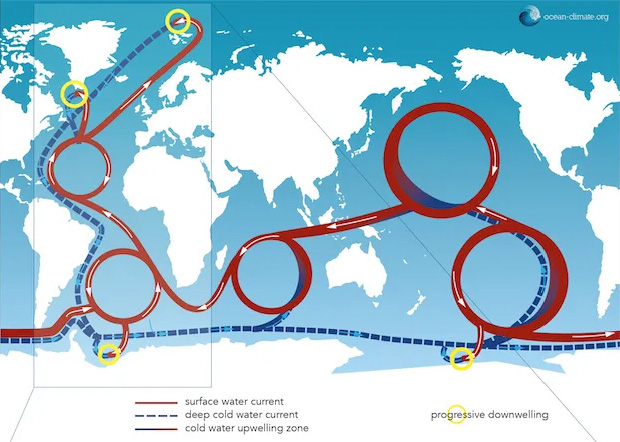Published on 15 March 2021
A conveyor belt acting as a thermostat
Induced by atmospheric factors and by differences in temperature and salinity of the waters, the AMOC (Atlantic meridional overturning circulation) distributes the warm waters of the low latitudes towards high latitudes. This system therefore makes it possible to rebalance the temperature differences between the tropical zones and the poles. In total, nearly 20 million cubic meters of water per second are displaced, nearly a hundred times the flow of the Amazon River.
Professor Stefan Rahmstorf, co-author of the study.
The ocean circulation is therefore a fundamental component of the Earth's climate system. The fear of a slowdown of the AMOC and the Gulf Stream—one of its components—as a result of global warming, has been a matter of concern for scientists for several decades now.
A weakening of the ocean currents in the Atlantic can indeed have very important consequences on a global scale. Among these, a significant drop in precipitation in the Sahel region, an increase in the frequency of storms and an increase in sea levels in North America and Europe, a significant drop in marine biological production and morecontrasted seasons in Europe (with harsher winters and very hot summers).

simplified diagram of global ocean circulation. Source: Plateforme Océan & Climat
An unprecedented weakening
A study recently published in the scientific journal Nature Geoscience shows that the Atlantic thermohaline circulation, very stable for about a millennium, has seen its activity decrease significantly over the last century due to global warming.
The difference in density between surface water and deep water drives the thermohaline circulation. At the end of their course from South to North, the surface waters have undergone a strong evaporation, resulting in a higher salt concentration.They are therefore denser than the cold unsalted waters coming from the poles. They therefore plunge to the depths of the ocean and create a deep current that heads south.
Due to warming, these surface waters are less dense due to their thermal expansion. In addition, melting glaciers and pack ice and changing precipitation patterns at high latitudes inject large amounts of fresh water into the surface waters of the oceans. This addition of fresh water also makes the water less salty, and therefore less dense.
Professor Stefan Rahmstorf.
Sea Surface Temperature
The temperature of the ocean's surface is a fundamental physical variable used to understand, quantify and predict the complex interactions between the ocean and the atmosphere. In conjunction with other ocean parameters, it is used to map historical trends in the AMOC and the Gulf Stream.
 Surface temperature of the North Atlantic Ocean as forecast by the Copernicus Marine Environment Monitoring Service, March 8, 2021
Surface temperature of the North Atlantic Ocean as forecast by the Copernicus Marine Environment Monitoring Service, March 8, 2021
The above image shows the surface temperature of the North Atlantic Ocean as forecast by the Copernicus Marine Environment Monitoring Service (CMEMS) on March 8, 2021. This service provides oceanographic products and services for maritime safety, coastal and marine environment monitoring, climate and meteorological forecasts and the use of marine resources. More than 150 products are thus obtained by combining in situ oceanic observations, satellite images provided by the Copernicus missions and oceanic forecast models updated daily.
Within the STEREO programme, as well as in the whole scientific community, the evolution of sea surface temperatures has been studied for a long time. 16 years ago, we broached the subject by commenting on an image acquired by the MODIS sensor on board NASA's Aqua satellite.
And 10 years ago, scientists funded by the STEREO programme as part of the HISEA project were already working to develop methods to obtain estimates of sea surface temperatures with better resolution both spatially and temporally.
Recognizing the importance of further improving our understanding of ocean, ice and land dynamics in the future, ESA recently selected the Harmony mission as one of the future Earth Explorer missions. In addition to a radar sensor making it possible to measure small changes in the Earth's surface, each Harmony satellite will carry an instrument operating in thermal infrared making it possible to measure the temperature differences at the sea surface.
More information
Atlantic Meridional Overturning Circulation at weakest point in a millennium (Copernicus website)
Current Atlantic Meridional Overturning Circulation weakest in last millennium (Nature Geoscience)
ESA moves forward with Harmony
In the Atlantic Ocean, Subtle Shifts Hint at Dramatic Dangers (The New York Times)
Climat : le grand courant marin de l’Atlantique se ralentit (Reporterre)
Fiche d'information "La circulation océanique" (Plateforme Océan & Climat)
